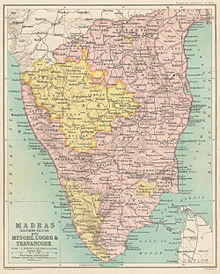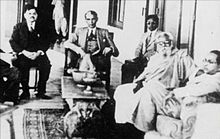Dravida Nadu
| Part of a series on |
| Dravidian culture and history |
|---|
 |
| Portal:Dravidian civilizations |
Dravida Nadu is the name of a proposed sovereign state demanded by the
Initially, the demand of Dravida Nadu proponents was limited to
The movement for Dravida Nadu was at its height from the 1940s to 1960s, but due to fears of Tamil hegemony, it failed to find any support outside
Background

The concept of Dravida Nadu had its root in the
Since the late 19th century, the anti-Brahmin Tamil leaders had stated that the non-Brahmin Tamils were the original inhabitants of the Tamil-speaking region.[9] The Brahmins, on the other hand, were described not only as oppressors, but even as a foreign power, on par with the British colonial rulers.[10]
The prominent Tamil leader,
The proponents of Dravida Nadu fabricated elaborate historical
The Indian National Congress, a majority of whose leaders were Brahmins, came to be identified as a Brahmin party.[8] Ramasamy, who had joined Congress in 1919, became disillusioned with what he considered as the Brahminic leadership of the party.[9] The link between Brahmins and Congress became a target of the growing Tamil nationalism.
In 1925, E.V. Ramasamy launched the
Characteristics and precursors
At the 14th Confederation of the Justice Party held in Madras in 1938, rules and regulations, or precursors of a Dravida Nadu were adopted. The objectives were defined as: to attain
The characteristics of the separate Dravida Nadu was described by E.V. Ramasamy as: the area then comprising Madras Presidency;
Justice Party

In December 1938, the Justice Party Convention passed a resolution stressing Tamil people's right to a separate sovereign state, under the direct control of the Secretary of State for India in London.[19]
In 1939, E.V.Ramasamy organised the Dravida Nadu Conference for the advocacy of a separate, sovereign and federal republic of Dravida Nadu.
E.V.Ramasamy was clear about the concept of a separate multi-linguistic nation, comprising
The proposition was made with a view to safeguarding the national self-respect of Dravidians threatened by Indo-Aryan culture, language, political leadership, and business interests. A separatist conference was held in June 1940 at Kanchipuram when Ramasamy released the map of the proposed Dravida Nadu. With the promised grant of full
In an interview with the
In July 1940, a secession committee was formed at the Dravida Nadu Secession Conference held in

In August 1941, E.V. Ramasamy declared that the agitation for Dravida Nadu was being temporarily stopped. The reason cited was that it was necessary to help the government in its war efforts. The agitation would be renewed after the conclusion of the war. Even though the agitation for Dravida Nadu was being stopped, the demand was very much intact. When the Cripps Mission visited India, a delegation of the Justice Party, comprising E.V.Ramasamy, W. P. A. Soundarapandian Nadar, Samiappa Mudaliar and Muthiah Chettiar, met the members of the Cripps Mission on 30 March 1942, and placed before them the demand for a separate Dravidian nation.[30] The demand was rebuffed by Cripps, who told them that such a demand would be possible only through a resolution in the Madras legislature or through a general referendum.[31][32]
In August 1944, E.V. Ramasamy created a new party called Dravidar Kazhagam out of the Justice Party, at the Salem Provincial Conference. The creation of a separate non-Brahmin Dravidian nation was a central aim of the party.[11] In 1944, when E.V.Ramasamy met the Dalit leader B. R. Ambedkar to discuss join initiatives, Ambedkar stated that the idea of Dravidistan was applicable to entire India, since "Brahminism" was "a problem for the entire subcontinent".[11]
At the Dravidar Kazhagam State Conference in
On 1 July 1947, the separatist Tamil leaders celebrated the "Dravida Nadu Secession Day".
When India achieved Independence in August 1947, Ramasamy saw it as a sad event that marked the transfer of power to "Aryans", while Annadurai considered as a step towards an independent Dravida Nadu, and celebrated it. Over the time, disputes arose between the two leaders. They fell out after Ramasamy anointed his young wife as his successor to lead the party, superseding senior party leaders.
Dravida Munnetra Kazhagam

In 1949, Annadurai and other leaders split up and established
In 1950, E.V.Ramasamy stated that Dravida Nadu, if it comes into being, will be a friendly and helpful state to India.[38] When the political power in Tamil Nadu shifted to the non-Brahmin K. Kamaraj in the 1950s, EVR's DK supported the Congress ministry.[39] In the late 1950s and early 1960s, the Dravida Nadu proponents changed their demand for an independent Dravida Nadu to an independent Tamil Nadu, as they did not receive any support from the non-Tamil Dravidian-speaking states.[40] Ramasamy changed the banner in his magazine Viduthalai from "Dravida Nadu for Dravidians" to "Tamil Nadu for Tamils".
The reorganisation of the Indian states along linguistic lines through the
However, by this time, DMK had taken over from DK as the main bearer of the separatist theme.
DMK's slogan of Dravida Nadu found no support in any state of India other than Tamil Nadu.[6][7] The non-Tamil Dravidian speakers perceived the ambitions of the Tamil politicians as hegemonic, ultimately leading to the failure of the Dravida Nadu concept.[44] C. Rajagopalachari, the former Chief Minister of Madras State and a Tamil Brahmin, stated that the DMK plea for Dravida Nadu should not be taken seriously.[45]
Decline
The decline in support for the Dravida Nadu within the DMK can be traced back to as early as the Tiruchi party conference in 1956, when the party decided to compete in the Tamil Nadu state assembly elections of 1957.[10] E.V.K. Sampath, who was leading a faction within DMK, argued that Dravida Nadu was "not feasible".[10] However, the party did state Dravida Nadu as a "long-range goal" during the elections.[46] The political observers doubted the seriousness of their demand for a sovereign state, and stated that the demand for a separate Dravida Nadu was just a side issue, and a slogan to catch the imagination of an emotional public.[10][47] In the 1957 elections, DMK managed to win only 15 of the 205 seats in the state assembly.[43]
In 1958, V. P. Raman, a Brahmin leader, joined the party and became a strong opponent of the Dravida Nadu concept. In November 1960, the DMK leaders, including Raman, decided to delete the demand of Dravida Nadu from the party programme at a meeting held in absence of Annadurai. Political scientist Sten Widmalm writes, "It seems that the more the party distanced itself from the demand for Dravida Nadu, the more it was supported."[10] In the 1962 election, DMK more than tripled its seats, winning 50 seats to the State Legislative Assembly, but still could not displace the Congress from power.
On 17 September 1960, a "Dravida Nadu Separation Day" was observed, which resulted in arrests of Annadurai and his associates.[48] The demand for a sovereign Tamil state was considered as a threat of Balkanization to India,[49] and also raised concerns among the Sinhalese politicians in Sri Lanka. In 1962, a Sinhalese M.P. stated in the Parliament: "The Sinhalese are the minority in Dravidistan. We are carrying on a struggle for our national existence against the Dravidistan majority."[50]
Annadurai, who had been elected to the upper house of Indian parliament (Rajya Sabha) in 1962, reiterated DMK's demand for independence for Dravida Nadu in his maiden speech on 1 May 1962. However, at the time of Sino-Indian War of 1962, he proclaimed that his party would stand up for the integrity and unity of India. A faction of DMK contended that the party should publicly abandon the demand for Dravida Nadu.[51]
In 1963, on the recommendation of the Committee on National Integration and Regionalism of the National Integration Council, the Indian parliament unanimously passed the Sixteenth Amendment to the Constitution, which sought to "prevent the fissiparous, secessionist tendency in the country engendered by regional and linguistic loyalties and to preserve the unity, sovereignty, and territorial integrity" of India. This was essentially in response to the separatist movement demanding a sovereign Dravidistan.[39][52]
At a party conference in 1963, DMK formally dropped the secessionist demand,
After DMK decided to relinquish its demand for Dravida Nadu, it devoted more attention to the language issue (
Resurgence
In the 1980s, a minor militant organisation called Tamil Nadu Liberation Army revived the demand for Dravida Nadu, when the Indian Peacekeeping Force (IPKF) was sent to Sri Lanka.
In 2017, when the Indian
References
- OCLC 9007066.
- OCLC 941238.
- ISBN 978-1-84331-032-7.
- OCLC 8165052.
- OCLC 6930110.
- ^ ISBN 0-8364-0222-7.
- ^ OCLC 814926.
- ^ ISBN 978-0-8018-7408-6.
- ^ ISBN 81-250-2895-1.
- ^ ISBN 978-0-7007-1578-7.
- ^ ISBN 978-0-691-08895-2.
- OCLC 17899446.
- ISBN 978-0-520-07589-4.
- ^ Arooran, K. Nambi (1980). "Tamil Renaissance and Dravidian Nationalism – The Demand for Dravida Nadu". TamilNation.org. Retrieved 20 December 2008. [dead link]
- ^ Saraswathi. Towards Self-Respect, p. 87.
- ^ Diehl, E.V. Ramasamy Naiker-Periyar, p. 27.
- ^ Saraswathi. Towards Self-Respect, p. 93.
- ^ Saraswathi. Towards Self-Respect, p. 98.
- OCLC 37770527.
- OCLC 24325282.
- ISBN 978-0-670-08328-2.
- OCLC 4449727.
- ^ Saraswathi. Towards Self-Respect, pp. 89 & 90.
- ISBN 0691088950.
- OCLC 35586.
- ISBN 81-250-0884-5.
- ISBN 81-7158-225-7.
- ^ ISBN 978-1-55587-967-9.
- OCLC 59991703.
- ^ Chatterjee, Up Against Caste: Comparative study of Ambedkar and Periyar, p. 43.
- ^ Kannan 2010, pp. 60
- ISBN 978-81-7033-860-4.
- ^ "C.N.Annadurai". 28 August 2007. Retrieved 5 September 2007. [dead link]
- ^ "The 60 days to Aug 15, 1947". Indo-Asian News Service. 15 August 2007. Retrieved 5 September 2007. [dead link]
- ^ C. Wijeyawickrema. "War and Peace in Sri Lanka: the other battle – Part I: South Indian backyard". Retrieved 5 September 2007.
- ISBN 1-85065-398-4.
- ^ Chatterjee, Debi, [January 1981](2004) Up Against Caste: Comparative study of Ambedkar and Periyar. Rawat Publications: Chennai, p. 42.
- ^ E. V. Ramaswami. Republic Supplement, 26 January 1950. Quoted in "Reconstruction of society". The Hindu. Chennai, India. 15 August 2007. Retrieved 5 September 2007. [dead link]
- ^ ISBN 81-250-0072-0.
- OCLC 175030.
- ISBN 1-55587-793-1.
- OCLC 5206379.
- ^ ISBN 978-0-521-80530-8.
- ISBN 0-631-20546-2.
- OCLC 301813.
- OCLC 4497385.
- OCLC 12978554.
- OCLC 342442.
- OCLC 95129.
- ISBN 978-0-7146-4732-6.
- OCLC 2197571.
- ISBN 978-0-691-02563-6.
- ^ Ramachandra Guha (16 January 2005). "Hindi against India". The Hindu. Chennai, India. Archived from the original on 25 February 2005. Retrieved 5 September 2007.
- OCLC 693687.
- ^ Twitterati in Kerala rakes up #DravidaNadu over 'beef ban'
- ^ South India’s mini rebellion over Modi’s new cattle law kindles an old secessionist spark
- ^ Sharma, Mihir (24 April 2018). "For rich South India, the rest of the country is a tax burden". ThePrint. Retrieved 23 July 2020.
- ^ T. S. Sudhir (14 March 2018). "South India's politicos echoing public anger with leadership in north, conciliatory leadership needed at Centre". Firstpost.
- ^ Mathi (16 March 2018). "தென்மாநிலங்கள் முன்வைக்கும் திராவிட நாடு கோரிக்கைக்கு ஆதரவு: ஸ்டாலின்" [DMK Working President MK Stalin said that his party will support "Dravida Nadu"]. OneIndia Tamil (in Tamil).
